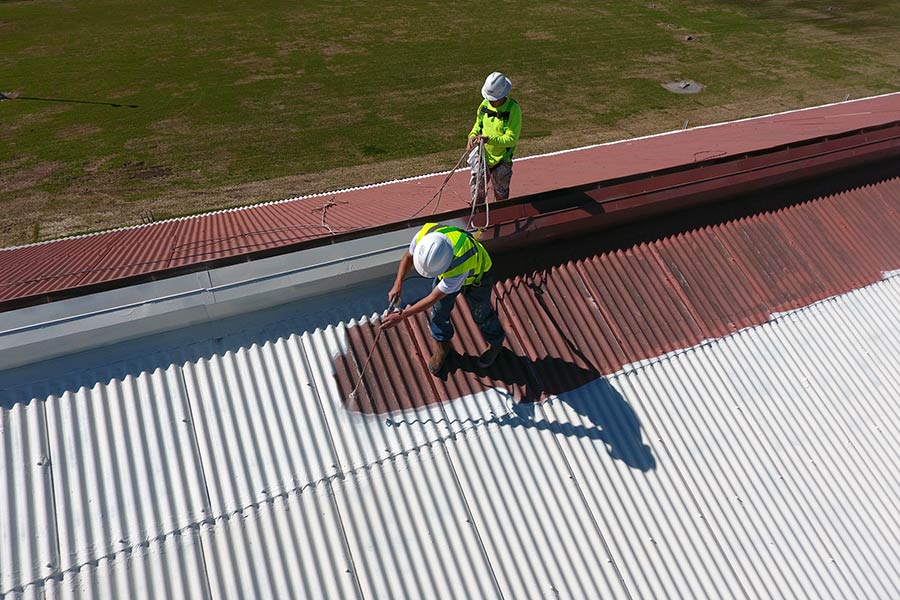
Butyl roof coatings—also known as “butyl rubber” or “butyl rubber roofing”—are elastomeric liquid sealants that can be applied to both flat and metal commercial roofs. Suitable substrates for butyl coating include metal, modified bitumen, built-up roof (BUR), single-ply, spray polyurethane foam, and concrete.
Derived from isobutylene, butyl can protect roofs against leaks and damage from the elements. What sets butyl coating apart from other coatings is its synthetic rubber (or “elastomeric”) qualities that make it extremely flexible and durable.
In addition to roof coatings, butyl rubber is also used to make rubber consumer products like rubber gloves, tires, sporting equipment, and even chewing gum.
The following is an in-depth look into the pros and cons of butyl roof coating.
The Pros of Butyl Roof Coating
Elongation & Tensile Strength
Perhaps the most significant feature of butyl elastomeric roof coating is its elongation and tensile strength due to being made of rubber.
Elongation determines how much a roofing membrane can stretch, while tensile strength determines its impact/shock absorbance.
Once cured, this solvent-based, polymer coating forms a flexible, durable, and seamless membrane that can withstand daily expansion and contraction (thermal cycling) of the roof structure.
Ponding Water Resistance
The rubber membrane’s durability also helps it withstand ponding water. When precipitation forms standing puddles on flat roofs, a strong roofing membrane can hold the moisture and prevent any leaks from occurring.
Vapor-Retardant Barrier
Butyl coatings are low in permeability (the state of a membrane that allows liquids or gases to pass through it), which gives them a vapor-retardant barrier. The vapor barrier makes butyl coatings ideal for use over spray polyurethane foam in cold storage or freezer applications.
UV Protection
Butyl coating membranes can reflect 80-90% of the sun’s UV rays, especially if the coating is white in color.
Building owners and facility managers can save thousands of dollars by drastically reducing cooling costs during the summer months. Minimizing the sun’s impact on the roof surface not only helps to sustain lower energy costs as the system ages, but it also reduces internal building temperatures and helps extend roof life.
The Cons of Butyl Roof Coating
Low Solids Content
Butyl coatings have a low solids content, which means that once the coating has completely cured, only a small percentage of solid material remains on the roof surface.
In this regard, butyl roof coatings are not as cost-effective as other roof coatings products, because more of the product must be applied to achieve the desired dry film thickness (DFT).
Challenging to Spray
As with any solvent-based material, butyl coating can be difficult on hydraulic spray equipment. Issues during the installation process are less likely to occur if the spray equipment is properly cleaned and maintained.
Lack of Color Stability
Unfortunately, butyl coatings are not color stable. Within 3-6 months after application of a butyl coating, exposure to the sun can fade colors on the roof, meaning butyl is not recommended for custom color applications.
We recommend that butyl coatings be top-coated with a white acrylic roof coating in order to retain the bright white finish.
Butyl Coating Materials We Provide
Butyl 310
Butyl 310 is an elastomeric coating is also suitable for metal (especially metal roofs with visible rust), modified bitumen, single-ply, and built-up roof (BUR) commercial roofing substrates.
Butyl 310 can also be applied in areas prone to leaks such as seams, fasteners, gutters, vent pipe flashings, air conditioning units, and expansion joints.
Butyl 310 is available in white, light gray, medium gray, and tan and ships in either 55-gallon drums or 5-gallon pails.
Click here to learn more about Butyl 310.
Conclusion
Butyl roof coatings are a highly effective roof restoration solution. The flexibility that butyl coatings provide is undeniable. There are several key factors to consider when choosing the best butyl roof coating for a commercial roofing environment.
If you are considering a butyl coating for your commercial facility, click here to schedule a free roof inspection with an American WeatherStar Approved Contractor.
Related Posts
The Pros and Cons of Urethane Roof Coatings
There are some important factors to consider when it comes to choosing this particular chemistry. Below, we highlight some key strengths and…
The Pros and Cons of Silicone Roof Coatings
When it comes to restoring and protecting commercial roof substrates, you would be hard-pressed to find a better solution than a silicone…
The Pros and Cons of Acrylic Roof Coatings
Often referred to as the “original” elastomeric coating, acrylic roof coatings are generally a popular choice for sloped metal roofs. However,…




